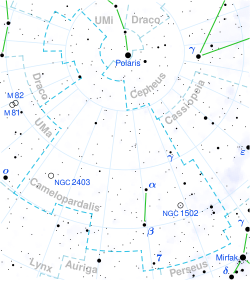HD 27022, also known as HR 1327, is a star located in the northern circumpolar constellation Camelopardalis. The object has also been designated as 20 H. Camelopardalis, but is not commonly used in modern times. It has an apparent magnitude of 5.27,[2] allowing it to be faintly visible to the naked eye. Based on parallax measurements from Gaia DR3, the star has been estimated to be 347 light years away.[1] It appears to be approaching the Solar System, having a heliocentric radial velocity of −19.5 km/s.[5]
| Observation data Epoch J2000.0 Equinox J2000.0 (ICRS) | |
|---|---|
| Constellation | Camelopardalis |
| Right ascension | 04h 20m 40.32564s[1] |
| Declination | +65° 08′ 25.5893″[1] |
| Apparent magnitude (V) | +5.27[2] |
| Characteristics | |
| Spectral type | G4 III[3] or G5 IIb[4] |
| U−B color index | +0.47[2] |
| B−V color index | +0.81[2] |
| Astrometry | |
| Radial velocity (Rv) | −19.47±0.21[5] km/s |
| Proper motion (μ) | RA: −28.439 mas/yr[1] Dec.: −4.4856 mas/yr[1] |
| Parallax (π) | 9.4068 ± 0.0643 mas[1] |
| Distance | 347 ± 2 ly (106.3 ± 0.7 pc) |
| Absolute magnitude (MV) | +0.31[6] |
| Details | |
| Mass | 2.88[7] M☉ |
| Radius | 10.71+0.23 −1.06[8] R☉ |
| Luminosity | 75.9[9] L☉ |
| Surface gravity (log g) | 3.10±0.21[10] cgs |
| Temperature | 5,425±33[11] K |
| Metallicity [Fe/H] | 0.03±0.05[10] dex |
| Rotational velocity (v sin i) | 0.5±1.4[12] km/s |
| Age | 444±60[7] Myr |
| Other designations | |
| Database references | |
| SIMBAD | data |
This is a solitary,[15] yellow giant with a stellar classification of G4 III.[3] It has alternatively been classified as G5 IIb wk,[4] indicating a bright giant with weak lines. HD 27022 is currently on the horizontal branch located on the warm end of the red clump,[16] a region of the said branch filled with metal-rich giant stars. It has 2.88 times the mass of the Sun but at the age of 444 million years,[7] it has expanded to 10.71 times its girth.[8] It radiates 75.9 times the luminosity of the Sun[9] from its enlarged photosphere at an effective temperature of 5,425 K.[11] Like most giants, it spins rather slowly, having a projected rotational velocity of 1⁄2 km/s.[12] Kinematically, it belongs to the halo of the Ursa Major moving group.[17]
References
edit- ^ a b c d e Vallenari, A.; et al. (Gaia collaboration) (2023). "Gaia Data Release 3. Summary of the content and survey properties". Astronomy and Astrophysics. 674: A1. arXiv:2208.00211. Bibcode:2023A&A...674A...1G. doi:10.1051/0004-6361/202243940. S2CID 244398875. Gaia DR3 record for this source at VizieR.
- ^ a b c d Ducati, J. R. (2002). "VizieR Online Data Catalog: Catalogue of Stellar Photometry in Johnson's 11-color system". VizieR Online Data Catalog. 2237. Bibcode:2002yCat.2237....0D.
- ^ a b Keenan, Philip C.; McNeil, Raymond C. (October 1989). "The Perkins Catalog of Revised MK Types for the Cooler Stars". The Astrophysical Journal Supplement Series. 71: 245. Bibcode:1989ApJS...71..245K. doi:10.1086/191373. ISSN 0067-0049.
- ^ a b Keenan, P. C.; Pitts, R. E. (April 1980). "Revised MK spectral types for G, K ANS M stars". The Astrophysical Journal Supplement Series. 42: 541–563. Bibcode:1980ApJS...42..541K. doi:10.1086/190662. ISSN 0067-0049.
- ^ a b Soubiran, C.; Bienaymé, O.; Mishenina, T. V.; Kovtyukh, V. V. (9 January 2008). "Vertical distribution of Galactic disk stars". Astronomy & Astrophysics. 480 (1): 91–101. arXiv:0712.1370. Bibcode:2008A&A...480...91S. doi:10.1051/0004-6361:20078788. eISSN 1432-0746. ISSN 0004-6361.
- ^ Anderson, E.; Francis, Ch. (May 2012). "XHIP: An extended hipparcos compilation". Astronomy Letters. 38 (5): 331–346. arXiv:1108.4971. Bibcode:2012AstL...38..331A. doi:10.1134/S1063773712050015. eISSN 1562-6873. ISSN 1063-7737. S2CID 119257644.
- ^ a b c Feltzing, S.; Holmberg, J.; Hurley, J. R. (October 2001). "The solar neighbourhood age-metallicity relation - Does it exist?". Astronomy & Astrophysics. 377 (3): 911–924. arXiv:astro-ph/0108191. Bibcode:2001A&A...377..911F. doi:10.1051/0004-6361:20011119. eISSN 1432-0746. ISSN 0004-6361.
- ^ a b Brown, A. G. A.; et al. (Gaia collaboration) (August 2018). "Gaia Data Release 2: Summary of the contents and survey properties". Astronomy & Astrophysics. 616. A1. arXiv:1804.09365. Bibcode:2018A&A...616A...1G. doi:10.1051/0004-6361/201833051. Gaia DR2 record for this source at VizieR.
- ^ a b Luck, R. Earle (September 2015). "Abundances in the Local Region. I. G and K Giants". The Astronomical Journal. 150 (3): 88. arXiv:1507.01466. Bibcode:2015AJ....150...88L. doi:10.1088/0004-6256/150/3/88. ISSN 0004-6256.
- ^ a b da Silva, Ronaldo; Milone, André de C.; Rocha-Pinto, Helio J. (August 2015). "Homogeneous abundance analysis of FGK dwarf, subgiant, and giant stars with and without giant planets". Astronomy and Astrophysics. 580: A24. arXiv:1505.01726. Bibcode:2015A&A...580A..24D. doi:10.1051/0004-6361/201525770. ISSN 0004-6361.
- ^ a b Stassun, Keivan G.; et al. (9 September 2019). "The Revised TESS Input Catalog and Candidate Target List". The Astronomical Journal. 158 (4): 138. arXiv:1905.10694. Bibcode:2019AJ....158..138S. doi:10.3847/1538-3881/ab3467. eISSN 1538-3881.
- ^ a b Gray, David F.; Toner, C. G. (November 1986). "Rotation and macroturbulence in bright giants". The Astrophysical Journal. 310: 277. Bibcode:1986ApJ...310..277G. doi:10.1086/164681. eISSN 1538-4357. ISSN 0004-637X.
- ^ Verbunt, F.; van Gent, R. H. (June 2010). "The star catalogue of Hevelius". Astronomy and Astrophysics. 516: A29. Bibcode:2010A&A...516A..29V. doi:10.1051/0004-6361/201014003. eISSN 1432-0746. ISSN 0004-6361.
- ^ "HD 27022". SIMBAD. Centre de données astronomiques de Strasbourg. Retrieved 22 September 2022.
- ^ Eggleton, P. P.; Tokovinin, A. A. (11 September 2008). "A catalogue of multiplicity among bright stellar systems". Monthly Notices of the Royal Astronomical Society. 389 (2): 869–879. arXiv:0806.2878. Bibcode:2008MNRAS.389..869E. doi:10.1111/j.1365-2966.2008.13596.x. eISSN 1365-2966. ISSN 0035-8711.
- ^ Alves, David R. (20 August 2000). "K-Band Calibration of the Red Clump Luminosity". The Astrophysical Journal. 539 (2): 732–741. arXiv:astro-ph/0003329. Bibcode:2000ApJ...539..732A. doi:10.1086/309278. eISSN 1538-4357. ISSN 0004-637X.
- ^ Chupina, N. V.; Reva, V. G.; Vereshchagin, S. V. (4 May 2006). "Kinematic structure of the corona of the Ursa Major flow found using proper motions and radial velocities of single stars". Astronomy & Astrophysics. 451 (3): 909–916. Bibcode:2006A&A...451..909C. doi:10.1051/0004-6361:20054009. eISSN 1432-0746. ISSN 0004-6361.
